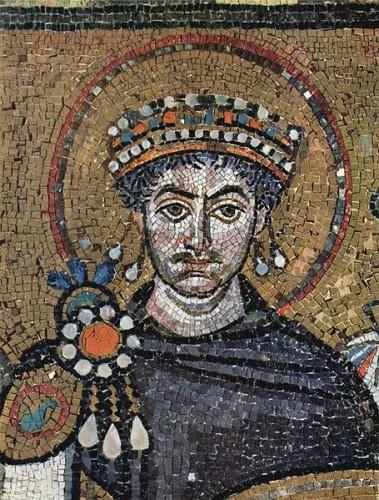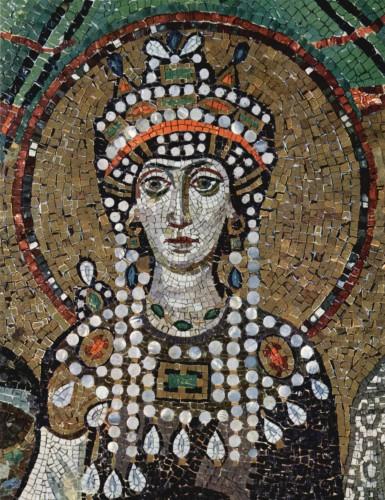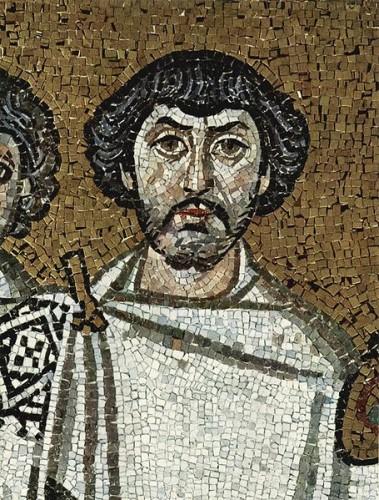Part.2
In the course of Justinian’s reign, the empire recovered a great deal of lost territory, including most of the North African littoral and the whole of Italy, but it did so at enormous cost and only because the emperor was served by some of the most able of Byzantine heroes—the great general Belisarius, who has good claim to be ranked alongside Alexander, Napoleon and Lee; an aged but vastly competent eunuch named Narses (who continued to lead armies in the field into his 90s); and, perhaps most important,John of Cappadocia, the greatest tax administrator of his day. John’s chief duty was to raise the money needed to fund Justinian’s wars, and his ability to do so made him easily the most reviled man in the empire, not least among the Blues and Greens.
Justinian had a fourth adviser, though, one whose influence over him was even more scandalous than the Cappadocian’s. This was his wife, Theodora, who refused to play the subordinate role normally expected of a Byzantine empress. Theodora, who was exceptionally beautiful and unusually intelligent, took an active role in the management of the empire. This was a controversial enough move in itself, but it was rendered vastly more so by the empress’s lowly origins. Theodora had grown up among the working classes of Byzantium. She was a child of the circus who became Constantinople’s best known actress—which, in those days, was the same thing as saying that she was the Empire’s most infamous courtesan.

The Emperor Justinian, from a mosaic at Ravenna. Image: Wikicommons.
Thanks to the Secret History of the contemporary writer Procopius, we have a good idea of how Theodora met Justinian in about 520. Since Procopius utterly loathed her, we also have what is probably the most uncompromisingly direct personal attack mounted on any emperor or empress. Procopius portrayed Theodora as a wanton of the most promiscuous sort, and no reader is likely to forget the picture he painted of a stage act that the future empress was said to have performed involving her naked body, some grain, and a gaggle of trained geese.
From our perspective, Theodora’s morals are of less importance than her affiliations. Her mother was probably an acrobat. She was certainly married to the man who held the position of bear-keeper to the Greens. When he died unexpectedly, leaving her with three young daughters, the mother was left destitute. Desperate, she hastily remarried and went with her infant children to the arena, where she begged the Greens to find a job for her new husband. They pointedly ignored her, but the Blues—sensing the opportunity to paint themselves as more magnanimous—found work for him. Unsurprisingly, Theodora thereafter grew up to be a violent partisan of the Blues, and her unswerving support for the faction became a factor in Byzantine life after 527, when she was crowned as empress—not least because Justinian himself, before he became Emperor, had given 30 years of loud support to the same team.

Justinian's empress, Theodora, a leading supporter of the Blues, rose from the most humble beginnings, captivating the emperor with her beauty, intelligence and determination.
These two threads—the fast-growing importance of the circus factions and the ever-increasing burden of taxation—combined in 532. By this time, John of Cappadocia had introduced no fewer than 26 new taxes, many of which fell, for the first time, on Byzantium’s wealthiest citizens. Their discontent sent shock waves through the imperial city, which were only magnified when Justinian reacted harshly to an outbreak of fighting between the Greens and the Blues at the races of January 10. Sensing the disorder had the potential to spread, and eschewing his allegiance to the Blues, the emperor sent in his troops. Seven of the ringleaders in the rioting were condemned to death.
The men were taken out of the city a few days later to be hanged at Sycae, on the east side of the Bosphorus, but the executions were botched. Two of the seven survived when the scaffold broke; the mob that had assembled to watch the hangings cut them down and hustled them off to the security of a nearby church. The two men were, as it happened, a Blue and a Green, and thus the two factions found themselves, for once, united in a common cause. The next time the chariots raced in the Hippodrome, Blues and Greens alike called on Justinian to spare the lives of the condemned, who had been so plainly and so miraculously spared by God.
Soon the crowd’s loud chanting took on a hostile edge. The Greens vented their resentment at the imperial couple’s support for their rivals, and the Blues their anger at Justinian’s sudden withdrawal of favor. Together, the two factions shouted the words of encouragement they generally reserved for the charioteers—Nika! Nika! (“Win! Win!”) It became obvious that the victory they anticipated was of the factions over the emperor, and with the races hastily abandoned, the mob poured out into the city and began to burn it down.
For five days the rioting continued. The Nika Riots were the most widespread and serious disturbances ever to occur in Constantinople, a catastrophe exacerbated by the fact that the capital had nothing resembling a police force. The mob called for the dismissal of John of Cappadocia, and the Emperor immediately obliged, but to no effect. Nothing Justinian did could assuage the crowd.
On the fourth day, the Greens and Blues sought out a possible replacement for the emperor. On the fifth, January 19, Hypatius, a nephew of a former ruler, was hustled to the Hippodrome and seated on the imperial throne.
It was at this point that Theodora proved her mettle. Justinian, panicked, was all for fleeing the capital to seek the support of loyal army units. His empress refused to countenance so cowardly an act. “If you, my lord,” she told him,
wish to save your skin, you will have no difficulty in doing so. We are rich, there is the sea, there too are our ships. But consider first whether, when you reach safety, you will regret that you did not choose death in preference. As for me, I stand by the ancient saying: the purple is the noblest winding-sheet.
 Belisarius, the Byzantines' greatest general—he once conquered the whole of Italy with fewer than 10,000 men–led the troops who massacred 30,000 Greens and Blues in the Hippodrome to put an end to the Nika Riots.
Belisarius, the Byzantines' greatest general—he once conquered the whole of Italy with fewer than 10,000 men–led the troops who massacred 30,000 Greens and Blues in the Hippodrome to put an end to the Nika Riots.
Shamed, Justinian determined to stay and fight. Both Belisarius and Narses were with him in the palace, and the two generals planned a counterstrike. The Blues and the Greens, still assembled in the Hippodrome, were to be locked into the arena. After that, loyal troops, most of them Thracians and Goths with no allegiance to either of the circus factions, could be sent in to cut them down.
Imagine a force of heavily armed troops advancing on the crowds in the MetLife Stadium or Wembley and you’ll have some idea of how things developed in the Hippodrome, a stadium with a capacity of about 150,000 that held tens of thousands of partisans of the Greens and Blues. While Belisarius’ Goths hacked away with swords and spears, Narses and the men of the Imperial Bodyguard blocked the exits and prevented any of the panicking rioters from escaping. “Within a few minutes,” John Julius Norwich writes in his history of Byzantium, “the angry shouts of the great amphitheater had given place to the cries and groans of wounded and dying men; soon these too grew quiet, until silence spread over the entire arena, its sand now sodden with the blood of the victims.”
Byzantine historians put the death toll in the Hippodrome at about 30,000. That would be as much as 10 percent of the population of the city at the time. They were, Geoffrey Greatrex observes, “Blues as well as Greens, innocent as well as guilty; the Chrionicon Paschale notes the detail that ‘even Antipater, the tax-collector of Antioch Theopolis, was slain.’ ”
With the massacre complete, Justinian and Theodora had little trouble re-establishing control over their smoldering capital. The unfortunate Hypatius was executed; the rebels’ property was confiscated, and John of Cappadocia was swiftly reinstalled to levy yet more burdensome taxes on the depopulated city.
The Nika Riots marked the end of an era in which circus factions held some sway over the greatest empire west of China, and signaled the end of chariot racing as a mass spectator sport within Byzantium. Within a few years the great races and Green-Blue rivalries were memories. They would be replaced, however, with something yet more threatening–for as Norwich observes, within a few years of Justinian’s death theological debate had become what amounted to the empire’s national sport. And with the Orthodox battling the Monophysites, and the iconoclasts waiting in the wings, Byzantium was set on course for rioting and civil war that would put even the massacre in the Hippodrome in sorry context.
Sources
Alan Cameron. Circus Factions: Blues and Greens at Rome and Byzantium. Oxford: Clarendon Press, 1976; James Allan Evans. The Empress Theodora: Partner of Justinian. Austin: University of Texas Press, 2002; Sotiris Glastic. “The organization of chariot racing in the great hippodrome of Byzantine Constantinople,” in The International Journal of Sports History 17 (2000); Geoffrey Greatrex, “The Nika Revolt: A Reappraisal,” in Journal of Hellenic Studies 117 (1997); Pieter van der Horst. “Jews and Blues in late antiquity,” in idem (ed), Jews and Christians in the Graeco-Roman Context. Tübingen: Mohr Siebeck, 2006; Donald Kyle, Sport and Spectacle in the Ancient World. Oxford: Blackwell, 2007; Michael Maas (ed). The Cambridge Companion to the Age of Justinian. Cambridge: CUP, 2005; George Ostrogorsky. History of the Byzantine State. Oxford: Basil Blackwell, 1980; John Julius Norwich. Byzantium: The Early Centuries. London: Viking, 1988; Procopius. The Secret History. London: Penguin, 1981; Marcus Rautman. Daily Life in the Byzantine Empire. Westport [CT]: Greenwood Press, 2006.